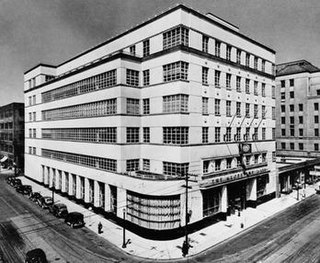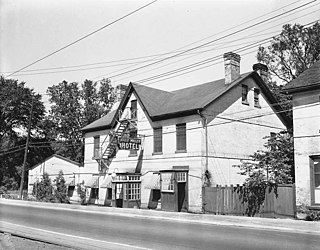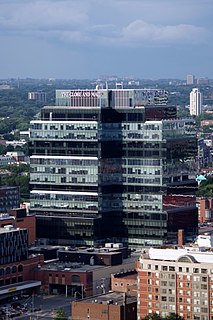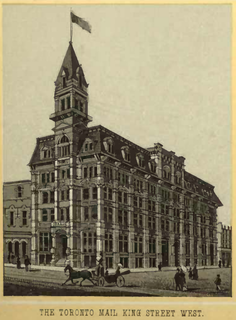
33 Dundas Street East is a studio complex located in Downtown Toronto, Ontario, Canada. The building was acquired by Rogers Media in 2007 as the new home of its four Toronto television stations: CITY-DT (Citytv), CFMT-DT (OMNI.1), CJMT-DT (OMNI.2) and formerly CityNews Channel. CITY-DT moved into the building on September 8, 2009, followed by the Omni stations a month later on October 19. First built in 2004, the building was home to Olympic Spirit Toronto, an Olympic-themed entertainment attraction, until 2006 and before that a three storey Salvation Army building.

The Battle of Montgomery's Tavern was an incident in the Upper Canada Rebellion. The abortive revolutionary insurrection inspired by William Lyon Mackenzie was crushed by British authorities and Canadian volunteer units near a tavern on Yonge Street, Toronto.

College Street United Church is a United Church of Canada church at the corner of College and Bathurst Streets in Toronto, Ontario, Canada. As of 1990 the church is part of the same structure as The Channel Club Condo at 456 College Street.

The Royal Bank Building refers to two office buildings built for the Royal Bank of Canada in the Financial District of Toronto, Ontario, Canada:

One Yonge Street is a 25-storey office building that serves as the headquarters of Torstar and its flagship newspaper, the Toronto Star. It is 100 metres tall, and is built in the International style. It was built as a replacement to the Old Toronto Star Building, which was located at 80 King Street West. That building was torn down to make room for First Canadian Place.

The William H. Wright Building was a six-storey office building located at 140 King Street West in Toronto, Ontario, at the corner of King and York streets. Designed by the firm Mathers and Haldenby and built between 1937 and 1938, it was one of Toronto's best examples of streamline moderne architecture. The building was home to The Globe and Mail newspaper and was named after the founder of that paper, William Henry Wright (1876-1951). In 1974 it was demolished to make way for the new Exchange Tower.

The Bank of Upper Canada Building is an 1827 bank building in Toronto, Ontario, Canada and one of the few buildings in Toronto that predates Toronto. It is located at 252 Adelaide Street East, in the Old Town district. Opened in 1827, in what was then York, it housed the Bank of Upper Canada until the bank's collapse in 1866. It was used for school purposes, and various commercial and industrial purposes before being restored in 1982 for commercial office space. It has been designated a National Historic Site of Canada since 1977.

The former Toronto Sun Building, at 333 King Street East at Sherbourne was built as the home of one of Toronto's daily English language newspapers, the Toronto Sun. Built in 1975, with a sixth floor added subsequently, the most notable feature of the structure was the large mural on the south side. The mural was 55 metres wide and 7.6 metres high, covering a long brick wall along Front Street. It was done in 1993 for the Sun by artist John Hood to celebrate the bicentennial of the founding of York. It depicts two hundred years of historic events in the city.

Yorkville Town Hall was the municipal building for the Town of Yorkville before annexation into the City of Toronto. Built in 1859-1860 by architect William Hay and his apprentice Henry Langley, the three-storey building served as an omnibus stop. The hall was located north of Bloor on Yonge Street on the west side.

The Arcade Building is a ten-storey office building with ground-floor retail in downtown Toronto, Ontario, Canada. It is known for the colourful LED lighting that has adorned its facade since 2008. The site was previously an indoor shopping arcade.

The Miller Tavern is an historical building located at 3885 Yonge Street, Toronto, Ontario. Originally called the York Mills Hotel, the three-storey building dates to the 1860s. A barn to house horses was located on the north side of the building. Following changes in ownership the hotel was later renamed The Jolly Miller after a local mill owner. It later catered to gamblers and was often raided.

Located on Albert Street, directly behind the Eaton's Main Store and Toronto's City Hall, the Eaton's Annex was a 10-storey building containing both retail and office space. By 1900, the Eaton's department store owned almost all of the lands within the city blocks bordered by Yonge Street, Queen Street West, Bay Street and Dundas Street, and the land was occupied by the Eaton's Main Store, the Annex building and various Eaton's warehouses and mail order buildings. The Main Store and the Annex, however, were the only two buildings open to the public. In 1900, the two buildings were connected by an underground passageway open to both employees and shoppers. It was the first underground pathway in Toronto open to the public, and is often credited as a historic precursor to Toronto's current downtown PATH network.

The Fashion District is a commercial and residential district in Downtown Toronto, Ontario, Canada. It is located between the intersection of Bathurst Street to the west, Spadina Avenue to the east, Queen Street West to the north and King Street to the south. Google Maps extends the district further east of Spadina Avenue to Peter Street.

The Toronto Athletic Club, also known as the Stewart Building, is a building located at 149 College Street in Toronto. It was designed by E. J. Lennox and built in 1894 to support the activities of the Club. It included the first indoor pool in Toronto. A similarly-named, but unaffiliated Toronto Athletic Club now exists in the Toronto-Dominion Centre.

Jarvis Street is a north-south thoroughfare in downtown Toronto, Ontario, Canada, passing through some of the oldest developed areas in the city. Its alignment extends from Queens Quay East in the south to Bloor Street in the north. The segment south of Front Street is known as "Lower Jarvis Street" while the segment from Bloor Street to Mount Pleasant Road is known as "Ted Rogers Way".

The Empress Hotel was a three-storey red-brick building at the corner of Yonge and Gould streets, in downtown Toronto, that was destroyed by fire on January 3, 2011. The hotel was opened in 1888. The hotel changed hands several times. The property ceased operating as a hotel in the mid-1970s.

Colborne Street is a street running several hundred metres east of Yonge Street in downtown Toronto, Ontario, Canada. It crosses Victoria Street and Leader Lane, ending at Church Street. It is located between and parallel to King Street East and Wellington Street East. The street is notable for retaining several historic buildings built during the reign of Queen Victoria.

The Milburn building was built in 1886 at 47-55 Colborne Street, in Toronto, Ontario, Canada, by architect Edward James Lennox. Lennox was well known for his work in Toronto for his work on more famous buildings like Casa Loma and Toronto's old city hall.

The Dixon Building and Griffiths Building are parts of a heritage building located on Front Street, Toronto, Ontario. The three-and-a-half storey building is an example of Second Empire architecture and was constructed in 1872-3 according to the designs of Walter Strickland.

The Globe and Mail Centre is a 17-storey building, on King Street East, in Toronto, Ontario, Canada, that houses the offices of The Globe and Mail newspaper, and other tenants. The building is adjacent to the former offices of rival newspaper the Toronto Sun, towering over it. Archeologists were allowed to excavate the foundations of Berkeley House, which were uncovered while removing a parking lot in preparation for digging foundations for the new building.

























